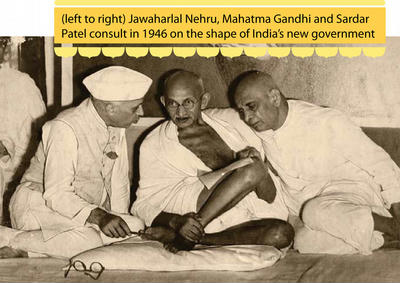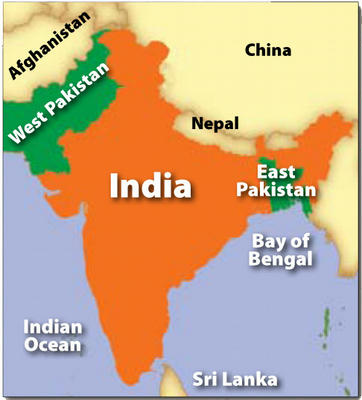
The World’s Largest Democracy Is Born
1. India’s independence in 1947 was accompanied by the violent Partition.
2. India is a sovereign republic and is the largest democracy in the world.
3. States were formed largely along linguistic lines.
4. India has remained a voice for freedom and peace despite border wars with Pakistan and China.
![]()
![]() HINDUISM TODAY’S Teaching Standards
HINDUISM TODAY’S Teaching Standards
This column in each of the three sections presents our subject outline for India and Hinduism from 1947 to the present.
1. Identify consequences of India’s independence for the Indian people and for other colonized peoples.
2. Describe difficulties in unifying a nation with many distinct political and linguistic regions.
3. Describe the Indian constitution and political system.
4. Explain the causes and results of India’s military conflicts since Independence.
If this were YOU...
It is 2004. Your family is part of a clan of blacksmiths who have lived in the same village for 1,000 years. You have learned the trade. But you did well in school and can go to college and take up a new profession. You would make more money, but would have to move to the city, breaking with tradition and leaving your parents alone in their old age.
Would you stay in your village or go to the city?
BUILDING BACKGROUND: From the first elections in 1951, every Indian citizen has had the right to vote, regardless of race, color, creed, gender or social standing. In 1913, Norway was the first country to allow all its citizens to vote. France only allowed women to vote in 1946. In the US, African Americans were not guaranteed voting rights until 1965.
Ending the Colonial Era
“At the stroke of the midnight hour, when the world sleeps, India will awake to life and freedom,” proclaimed India’s first prime minister, Jawaharlal Nehru, in India’s Parliament on August 15, 1947. “A moment comes, which comes but rarely in history, when we step out from the old to the new, when an age ends, and when the soul of a nation, long suppressed, finds utterance.” That moment set 370 million people free from two centuries of colonial rule.
Independence was accompanied by tragedy in the Partition. Pakistan was split off from India to form a Muslim-majority Islamic nation of 70 million people. West Pakistan lies adjacent to Afghanistan. East Pakistan, now Bangladesh, is at the mouth of the Ganga near Burma. Fifteen million people moved from Pakistan to India or vice versa in a dramatic and often violent population exchange. Over a million Hindus and Muslims died in riots and attacks that lasted months.
Newly free India led a worldwide movement to end colonialism. By 1954, Sri Lanka, Burma, Malaysia, Indonesia, and then Laos, Cambodia and Vietnam were freed. Independence soon came to Africa, once under near complete European domination. First Libya, in 1951, then Sudan, Tunisia, Morocco, Ghana, Guinea, Nigeria and so on. By the mid-1960s nearly all of Africa was liberated.
The Princely States
Newly independent India was diverse: 800 languages and dialects were spoken among 2,000 ethnic groups. Bringing unity to the ancient land after Partition was an amazing accomplishment by India’s leaders.
Within India’s borders were 17 provinces formerly under direct British rule and 562 virtually independent “princely states.” These states were also granted independence in 1947. In theory, each could have become a new country. In practice, however, those within newly-formed Pakistan were expected to join it, and the rest to become part of India.


Partitioned India
With Mahatma Gandhi’s blessings, Sardar Vallabhbhai Patel took on the job of negotiaing with the princely states. Patel contacted each prince or princess and explained the options: join India or stay independent. He then offered them all the time in the world to think about it—so goes the popular story—as long as he had their decision by that evening! The rulers had little choice. They had only held power because of British backing. The citizens of their realms were expecting the same freedoms as the rest of the country. In the end, the few who resisted were compelled to join.
The princely state of Jammu and Kashmir in northwest India was a different matter. Maharaja Hari Singh, the Hindu ruler of this Muslim-majority state, delayed in making a decision about which country to join until after independence. On October 22, 1947, militant Muslim tribals and Pakistani troops invaded the state. On October 26, Maharaj Singh agreed to join India. The Indian army was sent to defend Kashmir against the invaders, beginning the first of India’s several indecisive wars with Pakistan.
India’s Constitutional Structure
In 1947, a committee was formed to create India’s constitution. It was headed by Dr. B.R. Ambedkar of the Mahar caste (an “Untouchable Community”), who was one of India’s foremost legal scholars. The constitutional committee carefully studied the British, US and French governments, as well as traditional Indian political systems, choosing elements they felt were suitable for modern India. They unified the country by establishing a strong central government and setting a single pattern for state and local governments. They sought to ensure social equality and justice for every citizen.
The committee’s draft was debated and revised over the next two years and finally adopted on November 26, 1949. At 400 pages, it is the longest national constitution in the world, because it includes many laws that in other countries were set by their legislature or courts after a constitution was adopted.
The preamble begins: “We, the people of India, having solemnly resolved to constitute India into a sovereign, socialist, secular, democratic republic and to secure to all its citizens: Justice, social, economic and political; Liberty of thought, expression, belief, faith and worship; Equality of status and of opportunity; and to promote among them all Fraternity assuring the dignity of the individual and the unity and integrity of the nation.”
By comparison, the US constitution fits on four large pages, setting out only the spirit of the nation and the basic structure of the federal government. Individual US states have their own constitutions. India’s constitution details the structure of government right down to the village panchayat, or ruling council. The powers and responsibilities of government are assigned either to the Central Government or to the state governments, or shared. Powers not specifically given to the states are kept by the Central Government. In contrast, in the US Constitution, powers not specifically given to the federal government are kept by the states.
At both central and state levels, India’s government follows the British parliamentary system. The president is head of state, elected by the parliament. He or she serves for five years. The position is largely ceremonial, like that of the British monarch.
In India, elections are held every five years. The leader of the political party that commands a majority of seats in parliament becomes prime minister and forms a government with the approval of the president. If the party loses its majority, the “government falls” and new elections are called.
Establishing India’s States
A key power of India’s constitution permits the Central Government to merge or divide states as it sees fit. It used this power to reorganize the nation along linguistic lines. Areas where most of the people spoke the same language became one or more states. For example, the Tamil-speaking area of South India became Tamil Nadu. The Hindi-speaking region was split into several states. Having a single language made governing each state much easier. Today India has 28 states. It also has seven “Union Territories,” which are ruled directly by the Central Government.
International Relations
India was a founder of the Non-Aligned Movement (NAM) of nations. These nations, mostly of Asia, Africa and Central and South America, sided with neither the US nor the Soviet Union during the decades-long “Cold War” after World War II. Prime Minister Nehru was respected worldwide as one of NAM’s strongest voices for peace and freedom.
But peace was a challenge on India’s own borders. The hasty Partition left the subcontinent unstable. Pakistan’s invasion of Kashmir in 1947 led to two years of open war with India. India’s appeal to the UN resulted in a cease-fire. Since then, Kashmir has been divided by the “Line of Control,” separating Pakistan-occupied territory from India’s Kashmir. War broke out again in 1965 and also ended in stalemate. In 1989 Pakistan-backed Islamic separatists and infiltrators resumed violent attacks and riots. Since then, they have driven hundreds of thousands of Hindus out of Kashmir and worsened the security situation in the state.
In 1962 India lost a brief war with China over their disputed and ill-defined border in the Himalayas. The war was a deep personal shock to Nehru. He had taken at face value the Chinese government’s promise not to attack, even when warned by members of NAM to not be so trusting. India was badly prepared to defend against the Chinese and had to appeal to the US for support, which was a humiliating compromise of NAM principles.
India’s failure in the Chinese border war caused a complete rethinking of military strategy. Nehru’s successors, especially his daughter Indira Gandhi, turned India into a major modern military power armed with missiles and nuclear weapons.
Bangladesh
Since independence, citizens in Bengali-speaking East Pakistan felt neglected by their rulers, who were mostly Urdu-speaking people based in West Pakistan. East Pakistan demanded economic and political autonomy. A nationalist upheaval followed. West Pakistan responded in 1971 by sending 100,000 troops to brutally put down what they regarded as an outright revolt. Civil war followed. Ten million refugees fled to India forcing India to come to East Pakistan’s aid. In December, West Pakistan’s forces surrendered to the Indian army. East Pakistan became the independent nation of Bangladesh, and the refugees returned.

REVIEWING IDEAS, TERMS AND PEOPLE
1. Define: What event in India’s history is called the Partition? Why is it called the Partition?
2. Explain: How was Kashmir different from other states at independence? What has occurred as a result?
3. Compare: How does India’s government differ from that of the US at the federal and state levels?
4. Explain: How did India reorganize its states? How did the strategy help improve state government?
![]()
5. Analyze: What was the Non-Aligned Movement? How was India involved in NAM?
ACADEMIC VOCABULARY
utterance
expression, a voice to speak
partition
“divide into parts;” when capitalized, the separation of Muslim-majority Pakistan from the rest of British India
sovereign
independent
socialist
in this context: equal economic opportunity for all
secular
not based on religion; treating all religions the same under the law
fraternity
friendship and support within a group
Central Government
India’s term for what is called the “federal government” in the US
monarch
a royal head of state, especially a king, queen or emperor
linguistic
having to do with language
separatist
a person or group seeking to separate one territory from another, usually based on ethnicity or religion
autonomy
self government
